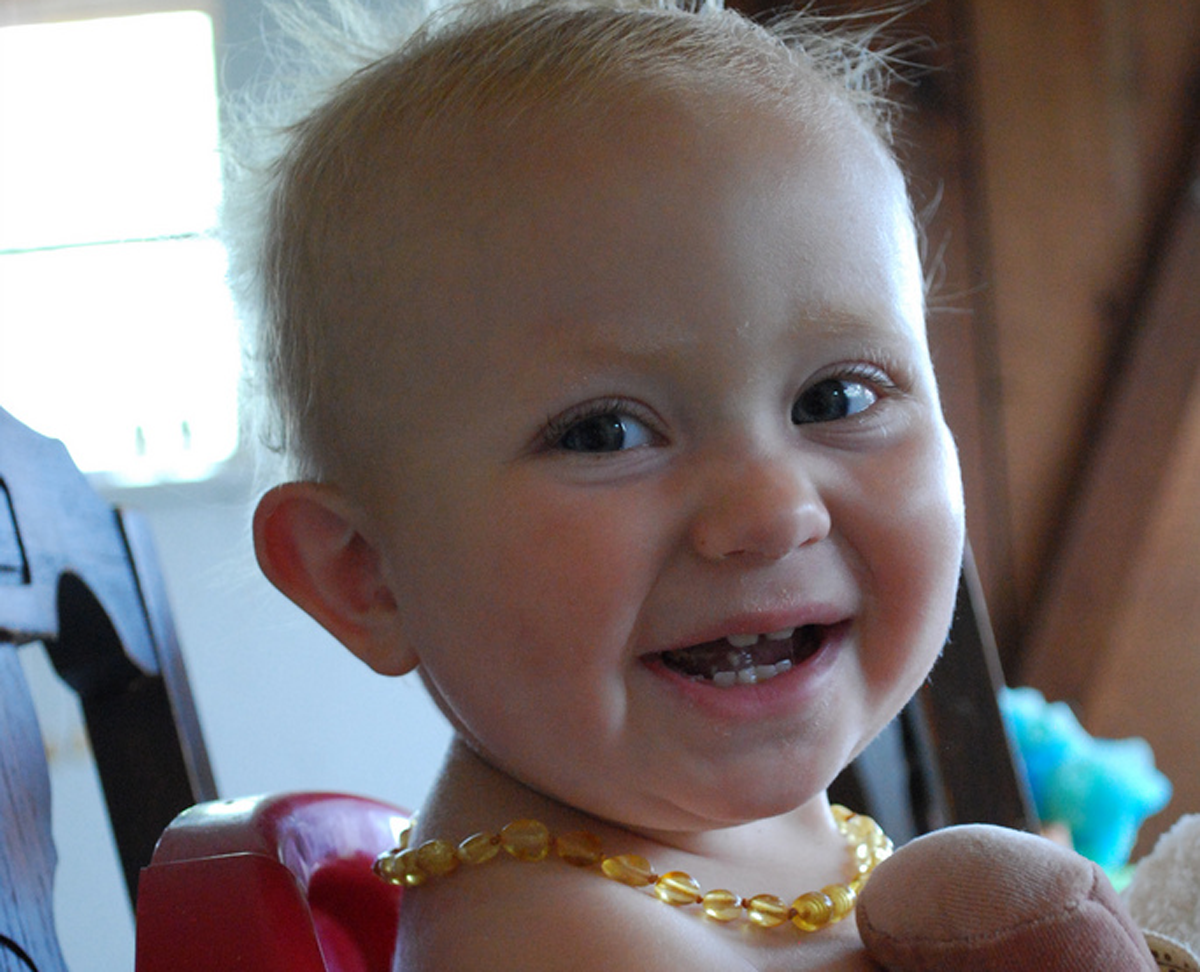Table of Contents
Before we can take a closer look at the claims made by people who are really enthusiastic about amber teething necklaces, we have to point out what their origins are. As advocates themselves will share, amber has been used in alternative healing for a very long time. Even more importantly though, amber has been a popular feature in children's jewelry since Medieval times. The reason is two-fold: by putting jewelry on a child, families could indicate wealth, and amulets that served the purpose of sending "evil spirits" packing were rather common during a time when infant deaths were an everyday occurrence and the scientific method hadn't yet been discovered.

Do Amber Teething Necklaces Actually Work?
Look at the claims made on the last page, and you'll see some interesting things. Sorry, folks, but appeals to authority aren't science. The fact that amber teething necklaces are sold in pharmacies in some places is completely irrelevant and doesn't prove they work. My pharmacy sells homeopathic remedies too. And hair clips. It may boost their sales, but doesn't infuse them with healing properties by virtue of sitting among real medications. Besides, baby necklaces need to comply with special EU standards — we'll get there in a bit.
Another claim that we haven't discussed yet is that parents of babies who wear amber teething necklaces are very satisfied and noticed a marked reduction in crying and fussing. We won't entertain that kind of "anecdata" here either.
Now, what about the idea that oils contained within amber somehow enter the bloodstream and then act as an analgesic? That claim is more interesting. The component in question is called succinic acid, and it is indeed present in Baltic amber and some other types of amber. As this succinic acid melts at 187 °C, which is rather significantly above human body temperature, it's quite unlikely that it would find its way into a baby's bloodstream when they wear an amber necklace. It is, however, possible that the acid is sweat-soluable.
Though succinic acid, often in the form of ground-up amber, does have a history as a pain remedy, there's no scientific evidence whatsoever that it actually works to relieve pain. In conclusion, we don't know whether the succinic acid in an amber necklace actually reaches the baby, nor whether it acts as an analgesic. In addition, I was quite shocked to find that some sellers of amber teething necklaces in my own locality (in Europe) were in fact peddling, quite openly, necklaces made out of artificial amber (that is, young resin or plastic). These definitely don't even contain succinic acid.
READ Dealing with Teething Pain: Remedies for Babies
Who Cares? If It Doesn't Help, It Won't Harm!
As pediatrician John Snyder, writing on Science-Based Medicine, points out:
"...My first reaction was to inform these parents of the dangers of necklaces or anything placed around an infant’s or young child’s neck. Strangulation is a known cause of accidental injury and death in children, and pediatricians are trained to discuss this as part of the routine anticipatory guidance we give to parents."
The amber in amber teething necklaces won't do your baby any harm in and of itself. However, if your crawling baby gets their necklace caught up in something, they face a very real risk of strangulation. That is why, in addition to pediatricians in many countries being trained to have chats with their patients' parents about exactly that, the EU has regulations covering strangulation risks. Amber teething necklaces are covered under European Union Stadards EN 71 and EN 12586. That means they have to have clasps that open automatically when they are subject to any tension.
Strangulation isn't the only risk we face here, either. Should the baby start chewing on the necklace only for the cord to snap and the beads to become loose, you have a choking problem on your hands. Do the benefits outweigh the risks? Considering the fact that there is zero evidence that amber necklaces help alleviate teething pain, the answer can only be a very resounding "no".
- Photo courtesy of gerrythomasen: www.flickr.com/photos/gerrythomasen/9708190694/
- Photo courtesy of
- Photo courtesy of lydialark: www.flickr.com/photos/lydialark/5813627458/
- Photo courtesy of lydialark: www.flickr.com/photos/lydialark/5813627458/
- amberbyamanda.com/Shipping-Returns-1.html
- www.healingamber.ca/About-Baltic-Amber_ep_41.html
- www.huggies.com.au/baby-care/health/teething/amber-teething-necklace
- www.bellybelly.com.au/baby/amber-teething-necklaces/
- www.sciencebasedmedicine.org/amber-waves-of-woo/
- scienceornot.net/2012/10/30/amber-necklaces-and-teething-babies/
- www.childsafetyeurope.org/publications/info/product-safety-guide.pdf


Your thoughts on this